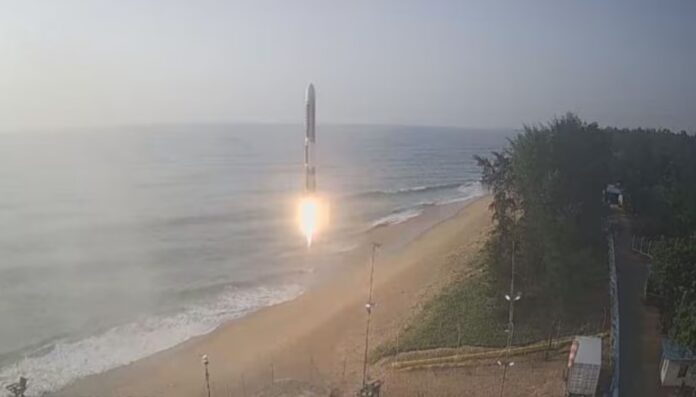May 30, 2024: Spacetech startup Agnikul Cosmos on May 30 successfully launched the Agnibaan SOrTeD rocket touted to be the world’s first 3D-printed rocket engine from Sriharikota, putting behind four previous attempts that were called off.
Commending the successful launch PM Modi wrote on X – A remarkable feat which will make the entire nation proud! The successful launch of Agnibaan rocket powered by world’s first single-piece 3D printed semi-cryogenic engine is a momentous occasion for India’s space sector and a testament to the remarkable ingenuity of our Yuva Shakti. My best wishes to the @AgnikulCosmos team for their future endeavours.
SOrTeD (SubOrbital Technological Demonstrator) is a single-stage rocket fueled by a semi-cryogenic engine. Developed in India, the vehicle was assembled at Agnikul’s facilities at IIT Madras, informed MoS – IT and Technology, Rajeev Chandrasekhar.
PM Modi applauds Agnikul Cosmos Agnibaan Rocket Successful Lift Off
Agnibaan SOrTeD (Sub-Orbital Technology Demonstrator) lifted off at 7.15 am on Thursday in a mission of many firsts. While it is the second launch by a private startup in India, it is the first to use a private launchpad that the company has set up at the country’s only operational spaceport at Sriharikota
Srinath Ravichandran, co-founder and CEO, Agnikul Cosmos, expressed, “This is the culmination of 1000s of hours of reviews and hard work by the team. We are blessed to have had the opportunity and the full support of IN-SPACe and ISRO to design and build original space worthy hardware in India.”
The Agnibaan rocket can carry up to 300 kg payload to a 700 km high orbit. The sophistication in Agnikul’s rocket launch arises from the fact that the launch vehicle ‘Agnibaan SOrTeD’ is using India’s first semi-cryogenic engine, which uses a mix of liquid and gas for propellant.
Prof. V. Kamakoti, Director, IIT Madras, said, “Sky is no more the limit for our startups. Very innovative, first time in the world, deep core technology demonstrated today by Agnikul – a great inspiration for all young students to boldly take the entrepreneurship route and become employers.”
IRSO too applauded the Agnikul team for the successful mission and said, “A major milestone, as the first-ever controlled flight of a semi-cryogenic liquid engine realized through additive manufacturing.”
Space regulator Indian Space Authorisation and Promotion Centre (IN-SPACe) chairman Pawan Goenka hailed the achievement a ‘historic moment for India’s space sector’. Goenka said the launch was powered by ‘world’s first single piece 3D printed semi-cryogenic engine’, showcasing the brilliance of India’s young innovators.
Typically, engine parts are manufactured separately and assembled later. Using the 3D-printed manufacturing process is likely to lower the launch cost and cut down the vehicle assembly time. The company aims to offer affordable launch services to small satellites.
Agnikul Cosmos also operates India’s first private launchpad in Sriharikota, which served as the launch site for this mission.
In the coming days, the startup is expected to foray into commercial missions in Q3 of FY 2024-2025, according to space regulator IN-SPACe’s manifesto. The startup is also expected to conduct launches in Q4 of FY 2024-2025.



